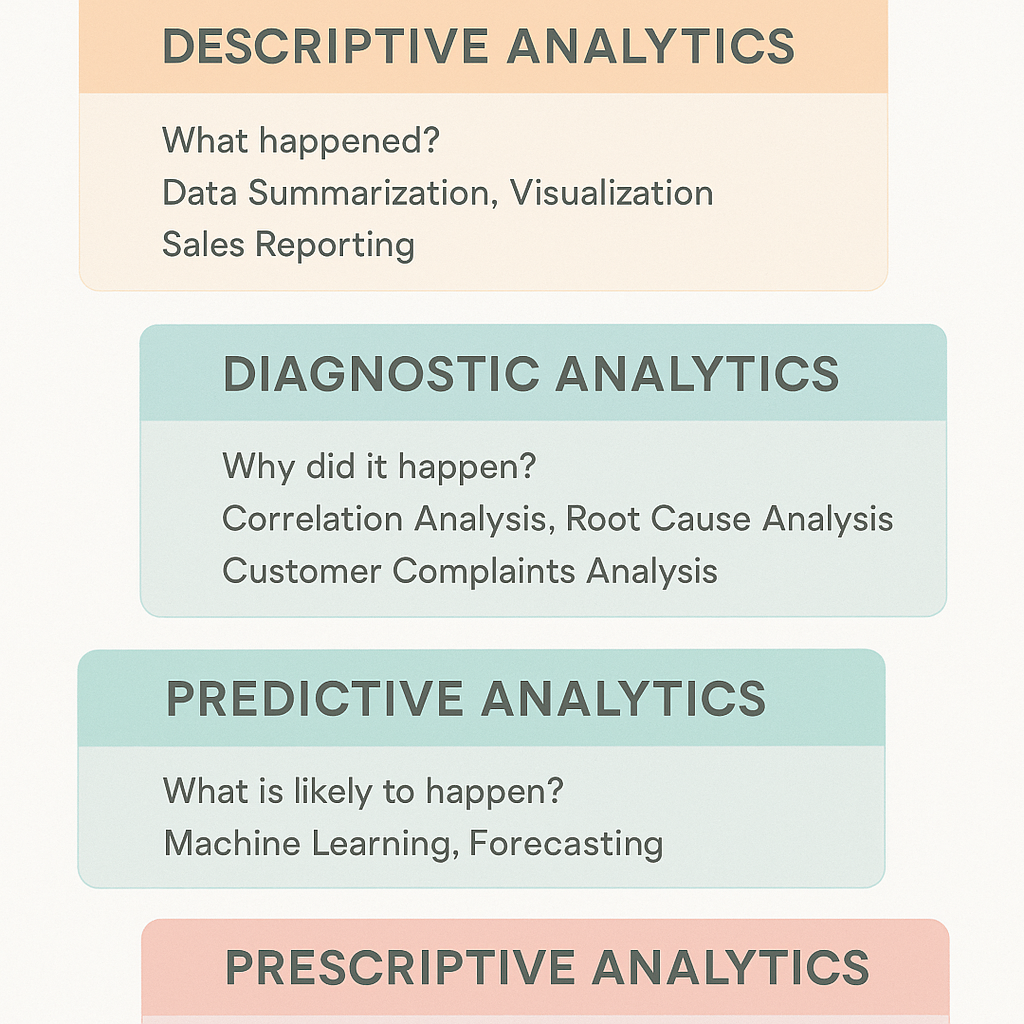Data and analytics have become fundamental drivers of modern business success, transforming raw information into actionable insights. Organizations across industries leverage analytical techniques to optimize operations, predict trends, and enhance decision-making processes. Understanding these concepts is crucial for navigating today’s information-driven economy.
Four Types of Analytics
Modern organizations use four distinct analytical approaches: descriptive analytics examines past events, diagnostic analytics explains why events occurred, predictive analytics forecasts future outcomes, and prescriptive analytics recommends optimal actions. Each type serves specific business needs and requires different techniques and tools.
Understanding data analytics and its significance
In today’s data-driven business environment, the ability to extract meaningful insights from vast amounts of information has become a critical competitive advantage. Organizations across all sectors are recognizing that effective data utilization can transform their operations, enhance customer experiences, and drive sustainable growth.
The Foundation of Modern Business Intelligence
Data analytics represents the systematic process of collecting, transforming, and organizing information to draw conclusions, make predictions, and drive informed decision-making across organizations. This multidisciplinary field employs mathematical, statistical, and computer science techniques to reveal patterns, trends, and correlations that would otherwise remain hidden within massive datasets. Companies that implement robust analytics strategies often demonstrate greater confidence in their strategic choices, becoming more proactive and financially astute in their market approach.
Cross-Industry Applications and Impact
The significance of data analytics extends across numerous industries, each leveraging analytical insights to address specific challenges and opportunities. In retail, businesses analyze customer purchasing patterns, inventory levels, and seasonal trends to optimize product offerings and supply chain management. A clothing retailer might examine sales data to determine which designs resonate with customers and which products should be discontinued, ensuring inventory aligns with consumer demand.
Healthcare organizations utilize analytics to improve patient outcomes and operational efficiency. Medical facilities analyze patient data, treatment effectiveness, and resource utilization to enhance care delivery while managing costs. Similarly, financial institutions employ sophisticated analytical models to assess credit risk, detect fraudulent activities, and personalize investment recommendations for clients.
Transformative Business Benefits
The implementation of data analytics delivers substantial benefits that directly impact organizational performance. Companies experience improved decision-making capabilities as they replace intuition-based choices with evidence-driven strategies. Cost reduction emerges through the identification of operational inefficiencies and resource optimization opportunities. Additionally, analytics enables organizations to enhance customer satisfaction by personalizing experiences and anticipating client needs, ultimately driving revenue growth and market competitiveness in an increasingly complex business landscape.

Types and techniques of data analytics
Building upon the fundamental understanding of data analytics’ significance in modern business, organizations must grasp the distinct types and techniques that form the backbone of effective data analysis. Each type serves a specific purpose in the analytical journey, from examining past events to predicting future outcomes and recommending optimal actions.
Descriptive Analytics: Understanding What Happened
Descriptive analytics represents the foundation of data analysis, focusing on summarizing historical data to answer the question “what happened?” This type employs techniques such as data aggregation and data mining to transform raw information into meaningful insights. Organizations utilize descriptive analytics to track key performance indicators, generate reports, and identify patterns in past business performance.
Common techniques include statistical measures like mean, median, and standard deviation, along with data visualization methods. For instance, a retail business might analyze sales data from the previous quarter to understand which products performed best during specific time periods, helping establish baseline metrics for future comparisons.
Diagnostic Analytics: Discovering Why Events Occurred
Diagnostic analytics delves deeper into historical data to determine the root causes behind specific outcomes. This analysis type answers “why did it happen?” through techniques such as drill-down analysis, correlation studies, and hypothesis testing. Organizations employ diagnostic analytics to identify factors that influenced particular results or trends.
For example, a manufacturing company experiencing production delays might use diagnostic techniques to examine various factors like equipment performance, staff scheduling, and supply chain disruptions to pinpoint the exact cause of inefficiencies.
Predictive Analytics: Forecasting Future Outcomes
Predictive analytics utilizes statistical modeling and machine learning algorithms to forecast future events based on historical patterns. This forward-looking approach employs techniques including regression analysis, time series forecasting, and classification models to answer “what will likely happen?”
Healthcare organizations frequently use predictive analytics to anticipate patient readmission rates, while financial institutions apply these techniques to assess credit risk and detect potential fraud before it occurs.
Prescriptive Analytics: Recommending Optimal Actions
Prescriptive analytics represents the most advanced type, providing specific recommendations for optimal decision-making. This analysis combines optimization algorithms, simulation models, and decision trees to suggest the best course of action given various constraints and objectives.
Transportation companies leverage prescriptive analytics to optimize delivery routes, considering factors like traffic patterns, fuel costs, and delivery deadlines to maximize efficiency and minimize operational expenses.

Tools and technologies in data analytics
The data analytics landscape relies on a diverse ecosystem of tools and technologies that enable professionals to extract meaningful insights from complex datasets. These solutions range from traditional spreadsheet applications to sophisticated cloud-based platforms and emerging artificial intelligence systems.
Essential Data Analytics Tools
Microsoft Excel remains a cornerstone tool for data analytics, offering powerful features for data manipulation, statistical analysis, and visualization. Its accessibility and widespread adoption make it an ideal starting point for basic analytics tasks, including pivot tables, data modeling, and chart creation. For more advanced visualization needs, Tableau has established itself as an industry leader, enabling users to create interactive dashboards and compelling data stories that communicate insights effectively across organizations.
Google Analytics serves as a specialized tool for web analytics, providing detailed insights into website performance, user behavior, and digital marketing effectiveness. This platform demonstrates how purpose-built tools can deliver targeted analytics solutions for specific business functions.
Cloud Computing Infrastructure
Cloud platforms have revolutionized data analytics by providing scalable storage and processing capabilities. Google Cloud Platform and Amazon Web Services offer comprehensive suites of analytics services, including data warehousing, real-time processing, and machine learning tools. These platforms eliminate the need for extensive on-premises infrastructure while providing the computational power necessary for handling massive datasets and complex analytical workloads.
Advanced Technologies Integration
Artificial Intelligence and machine learning algorithms are increasingly integrated into analytics workflows, enabling automated pattern recognition, predictive modeling, and anomaly detection. These technologies enhance traditional analytics by identifying subtle correlations and generating insights that might escape human analysis.
The Internet of Things (IoT) represents another technological frontier, generating continuous streams of sensor data from connected devices. When integrated with analytics platforms, IoT data provides real-time operational insights, enabling predictive maintenance, supply chain optimization, and enhanced customer experiences through data-driven automation and decision-making processes.

Becoming a data analyst: Skills and career paths
Building a successful career in data analytics requires a strategic blend of technical expertise and interpersonal abilities. The field offers diverse opportunities for professionals who can transform raw data into actionable business insights.
Essential Technical Skills for Data Analysts
Programming forms the foundation of data analytics careers. SQL remains the most critical skill, as it enables analysts to query databases and extract meaningful information. Statistical analysis capabilities are equally important, allowing professionals to identify patterns and validate findings through mathematical rigor.
Modern data analysts must master programming languages like Python and R, which facilitate advanced statistical modeling and machine learning applications. These tools enable analysts to handle complex datasets and perform sophisticated analyses that drive strategic decision-making.
Communication and Problem-Solving Abilities
Technical skills alone don’t guarantee career success. Effective communication stands as a cornerstone skill, enabling analysts to translate complex findings into clear, actionable recommendations for stakeholders. Problem-solving abilities help analysts approach challenges systematically and develop innovative solutions to business questions.
Data visualization skills complement communication efforts, allowing analysts to present insights through compelling charts and dashboards that resonate with diverse audiences across organizations.
Educational Pathways and Professional Development
Multiple educational routes lead to data analytics careers. Traditional computer science or statistics degrees provide strong foundations, while specialized data analytics programs offer focused training. Online platforms like Coursera and Google provide accessible certification programs that demonstrate practical competency to employers.
Professional certifications from organizations like SAS, Tableau, and Microsoft validate specific technical skills and enhance career prospects. Continuous learning remains essential as technologies evolve rapidly.
Career Advancement Opportunities
Data analytics offers excellent career progression potential. Entry-level positions typically include junior analyst roles, advancing to senior analyst, data scientist, or analytics manager positions. Specialized paths include business intelligence analyst, marketing analyst, or financial analyst roles, each requiring domain-specific knowledge alongside core analytical skills.

What to remember about data and analytics
Data and analytics represent a transformative force reshaping how organizations operate and compete. As technologies continue to evolve, emerging trends like real-time processing, automated insights, and edge computing will further expand analytical capabilities. The integration of artificial intelligence and machine learning will make sophisticated analysis more accessible to businesses of all sizes. Future developments may include enhanced visualization techniques, improved natural language processing for data queries, and greater democratization of analytical tools. Organizations that invest in building analytical capabilities today will be better positioned to adapt to tomorrow’s challenges and opportunities.